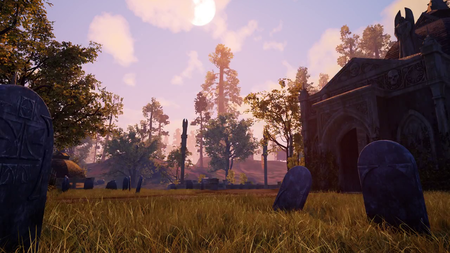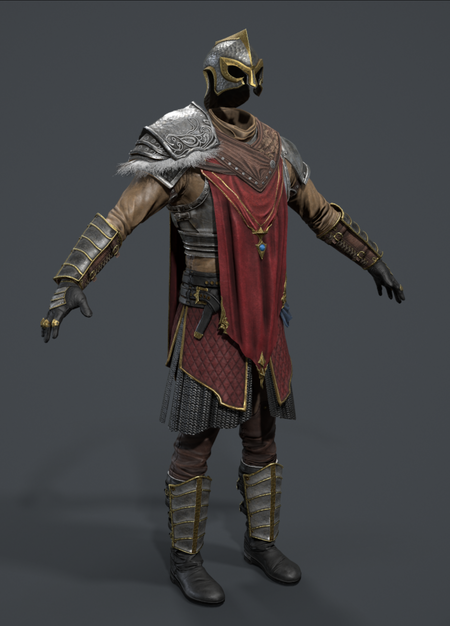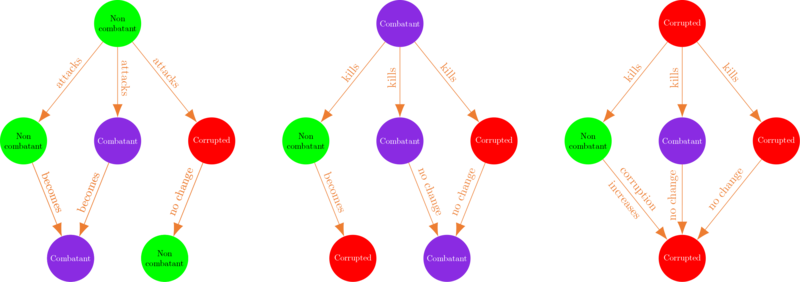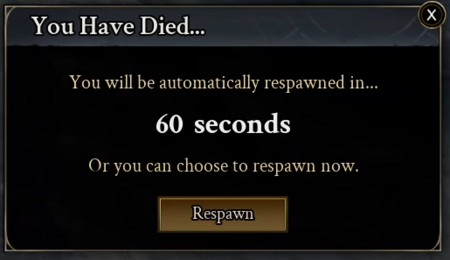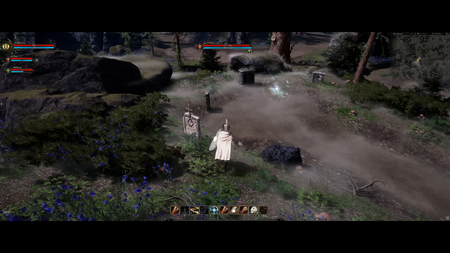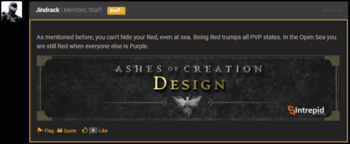Player corruption
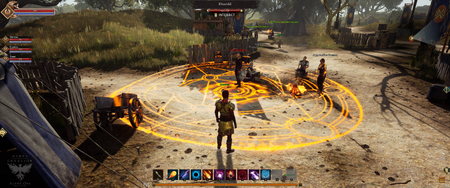
When you gain that corruption you have the potential of losing your completed items, your weapon, your armor, stuff that is very difficult to achieve; and then the other aspect of that is, that in order to deter basically players taking alternate characters and saying this is my PK alt, the more players you kill, the more corruption you gain, the higher your combat efficacy in PVP diminishes. If you're out there and you killed 20 players... you will not be able to perform in PVP any longer. You will need to take that character and go work off that corruption. The other aspect of corruption is that if you kill another player, who is a non-combatant and the level disparity between you and that player is great, you will gain a higher amount of corruption from that single kill. To the point where you should not be killing a level one character.[2] – Steven Sharif
If a combatant (purple) character, or their summon, kills a non-combatant (green) character, or any of their controlled entities, in Open-world PvP, they will be flagged as corrupted (red).[3][4][5] Corruption gained for killing controlled entities is a lower value than killing players.[3] Player corruption has been referred to as a status condition.[6]
- There is no incentive to go corrupt... There's zero incentive for a player to go red. It actually gives you negatives for doing that- very significant downsides.[7] – Steven Sharif
- The goal of the corruption system is to keep risk alive while significantly curtailing or deterring the ability for players to grief other players.[8][9]
- It is my expectation that the system will perform very well in keeping risk alive, but significantly curtailing or deterring the ability for players to grief.[9] – Steven Sharif
- A player's corruption score (corruption value) increases with each non-combatant player killed.[8][10][11][12] Corruption score has a scaling impact on the efficacy of a character's skills in PvP combat.[13][14] The higher the corruption score:
- The more skill and stat dampening applies until the corrupt player ultimately becomes ineffective at combat.[13][8][15][2][16][17] This dampening only affects PvP combat.[18]
- The more corruption you gain, the less effective you become in PvP and there's going to be a certain period at which point you have gained enough corruption that you're going to be gearless and you're also going to have a massive reduction in your PvP efficacy.[16] – Steven Sharif
- The higher chance of dropping of carried raw materials and gear (Weapons and Armor) when the corrupted player dies.[8][11][2][19][16]
- If you go on a murder spree and you have 10 pks under your belt then you might start feeling a significant dampening to your skill effects against other players. I don't want to give necessarily a number or curve for players to extrapolate prior to us having the ability to actually test these ideas and where those numbers are going to lie; but I would say what is the intent behind that dampening: The intent isn't to limit the fun of the player, the intent is to provide a give-and-take or a risk-versus-reward; and the risk of continuing down the road of accruing corruption is not only the loss of your gear and amplified death effects but also your ability to perform in that activity.[20] – Steven Sharif
- Corruption penalties occur as the corruption is gained.[21]
- Reward without risk is meaningless... Corruption is just another word for risk.[22] – Steven Sharif
- The wider the level disparity between the players, and the higher the attacker's PK value, the more corruption they gain.[8][15][10][11][12]
- Corruption value from PK'ing a non-combatant is based on level disparity along with the PKer's cumulative PK value.[10] – Steven Sharif
- Corrupt players suffer death penalties at four times the rate of a non-combatant.[8][11]
- Death penalties for corrupt players apply in every location, including naval PvP zones.[23]
- You can't necessarily time perfectly the damage or understand even the health of the player. Unless you were in their party you cannot see an opponent's health as well, so that's another component that adds risk..[24] – Steven Sharif
- Corrupted players remain corrupted when they enter naval PvP zones.[23][25][26]
- Corrupted players can be attacked regardless of other affiliations. This is something that will be tested during Alpha-2.[6]
- Corrupted players may kill bounty hunters without acquiring additional corruption score.[32][33]
- Corrupted player's combat penalties do not apply when battling bounty hunters.[32]
- Player to player trading, interacting with vendors or NPCs, and the ability to access storage is disabled for corrupted players.[34][8][35]
- Previously it was stated that corrupted players could not store items in public warehouses but could utilize private storage within their freehold.[8][35]
- Corrupted players will still be able to enter and leave their freehold buildings but may not deposit or withdraw items from storage.[34]
- There is a 60 second timer to logout while corrupt. Force-disconnecting the client during the cooldown will leave the character in-game.[13][36]
- Q: Will there be any large-scale consequences when many players in a group guild region religion etc become corrupted frequently or for an extended period of time?
- A: There are not group dynamics or mechanics that revolve around mass murdering people in the world. The corruption system is intended to deter mass murdering, not to provide incentives by which players can go out and gain corruption.[37] – Steven Sharif
- Q: If my guild has no one corrupted and your guild is like always killing people and always corrupted, will your guild have repercussions because they're corrupted versus my guild?
- A: No I don't think so either. And the reason why is we want to deter it, but we don't want to make the system meaningless; and if the deterrent becomes too heavy-handed then it's a system without a purpose. And I think that the intent behind the corruption is that like during a rise in passion and like anger and whatever you want to make this decision and do something and you'll suffer the repercussions later. But if those repercussions are just overwhelmingly bad and even anti-social in the sense that like your guild is like hey man you went corrupted and this gives us like corruption points on the guild, and like you're out of here, then people just aren't going to choose to use it; and then at which point might as well just take it out. So I think there's a healthy balance between the type of deterrent used.[38] – Steven Sharif
- Players do not lose gold upon death, no matter their corruption level.[39]
- Player corruption is different to the corruption found in corrupted areas.[40][41]
- Corruption has a visible effect on a player’s appearance.[42]
Removing corruption
The primary means to remove corruption is through death. Multiple deaths may be necessary to remove all corruption.[44][27]
- Dying removes a significant portion of a player's corruption score.[45]
- Gaining experience will also slowly reduce a player's corruption score.[46][15][44]
- Any experience that's gained by the player, whether it be through achievements in crafting, or in adventuring, or through other types of achievements: All of that experience goes towards your adventuring class experience gained; and then some experience can dual purpose towards professions as well. So if I reach an achievement in my crafting profession and that grants me additional experience within that profession to rank up, it will also grant the same amount of experience over in my adventuring level; and to that point, anytime you gain adventuring experience you tick away at the corruption.[46] – Steven Sharif
- A quest may be utilized to reduce the player kill (PK) count of a corrupt player in order for them to accumulate less corruption score in the future.[47][45]
- Corruption duration is reduced in military nodes.[49]
Bounty hunters
Players can acquire the bounty hunter title through a quest available to citizens of Military Stage 4 (Town) nodes and potentially their vassals or affiliated nodes.[50][12]
- Bounty hunters can activate their Pathfinding ability to reveal corrupted player locations on their map.[51][52]
- This will flag the bounty hunter for combat only to corrupted players for a period of one hour from the time of activation.[51]
- The pathfinding ability can be toggled on or off.[51][53]
- It is possible that bounty hunters will be permanently flagged versus corrupted players with the pathfinding ability toggled off. This design change will be decided based on testing.[54]
- The accuracy of bounty hunter maps is determined by a player's progression in the bounty hunter system.[55]
- Corrupted players may kill bounty hunters without acquiring additional corruption score.[32][33]
- Corrupted player's combat penalties do not apply when battling bounty hunters.[32]
- Chief bounty hunter is a node government title that grants special access to NPCs in a node.[56]
- Credit for killing a corrupted player goes to the bounty hunter who lands the last hit (killing blow). This may be changed to damage contribution in future.[57]
Bounty hunter maps
Corrupted players with a high enough corruption score will be visible on the world and mini maps. These players will have markers posted on the map by an NPC from a Military node of at least stage 4 (Town), and will only be granted to players who have the Bounty hunter title.[51][58] The accuracy of bounty hunter maps is determined by a player's progression in the bounty hunter system.[55]
Taverns are one of the locations that bounties will be posted. As players gain corruption, taverns may offer bounties to eliminate those players; or have a specific area cleared of problem players, thus giving a POI (point of interest) on the world map.[59]
Bounty hunter Pathfinding ability
| Skill | Icon | Origin | Description |
|---|---|---|---|
| Pathfinding | Bounty hunter | Reveals corrupted player locations on the bounty hunter's map.[51][60] Activating this ability will flag the bounty hunter for combat only to corrupted players for a period of one hour from the time of activation.[51] The pathfinding ability can be toggled on or off.[51][53] |
Corrupt players killing bounty hunters
Corrupted players potentially gain rewards for killing bounty hunters.[61]
NPC guards
NPC guards will kill corrupted players on sight.[63]
- NPC guards are capable of being killed, but they have high skill levels, damage mitigation, and power levels.[64]
- Guards are capable of being killed. However, that is a very tall barrier to surpass; meaning that their skill level is relatively high. Their damage mitigation, their output, and power: those things are very difficult to overcome. But they can be killed; and again you can upgrade guards through policies, through upgrades within the barracks structures; and you can even place mercenaries and guards ahead of certain events.[64] – Steven Sharif
- Mayors of nodes can unlock higher tier NPC guards through policies or by upgrading their barracks service building.[64][65][66][67]
- NPC guards may be available for hire to defend freeholds after a successful node siege.[68] NPC guards that permanently exist on a freehold are not a planned feature.[69]
Player flagging
The open world PvP flagging system is designed to deter people from griefing other players without limiting opportunities for open conflict.[70][71][7][5]
- We do incentivize players to fight back, or to participate in PvP through the flagging system, but not to PK. Not to go corrupt.[7] – Steven Sharif
- Players can participate in open world PvP with one another without having to resort to murder.[72]
- Players will gank other players, but the intention is for Ashes of Creation to not be a "gank box".[72]
- The penalties are intended to be severe enough to deter any type of spawn camping.[73]
- Summons follow the same PvP flagging rules as players and share the player's flag status.[4][74]
- Items are not provided to players until crafting or gathering interactions are complete. Players interrupted before completion will not lose these items or resources.[75]
There are three levels of flagging for world PvP in Ashes of Creation.[12]
- Non-combatant (green)
- All players start as non-combatants.[27]
- Non-forced attacks, including AoE and status effects, will not hit non-combatant players.[76][77]
- Green players killed by mobs (the mob deals the killing blow) do not flag attacking players as corrupt, but since the exact health of another player is not known (outside of the same party, raid, alliance, or guild), attackers run the risk of killing the player and becoming corrupt.[78]
- Player abilities with CC effects do not apply to non-combatants. The target of a CC ability must be flagged in order to suffer the CC effects. This prevents players from opening attacks that stun non-combatant players during a pull for example.[15]
- Non-combatants will not be flagged for looting bodies.[79]
- Players will be able to opt-in (via a checkbox) to allow their beneficial spells, or non-beneficial AoEs to hit combatants.[80][81]
- If you have that check-box for flagging with your AOEs and heals available then you will flag. If you do not have that box checked then on completion of the skill it will not flag you because the check was made at the start that there was a flagged party member; and then he will not he or she will not receive the beneficial effect as a result or the damage, if it's an offensive spell.[81] – Steven Sharif
- Combatant (purple)
- Players are flagged as combatants if they attack another (non-corrupted) player when carrying out a forced attack. If the attacked player fights back, they are also flagged as combatants, otherwise the attacked player will remain flagged as a non-combatant.[80][82][27]
- This also applies to attacks made by combat pets, summons, or any other player-controlled entities.[4][83]
- Non-combatants entering an open world battleground (PvP event) are automatically flagged as combatants and remain flagged for a period of time after leaving that battleground.[12]
- Non-combatants who heal, buff, or otherwise interact with combatants or corrupted players will be flagged as combatants.[13][28][29][30]
- Players can kill combatants without repercussions, and are encouraged to do so, since dying while a combatant has reduced death penalties.[27]
- Players are not able to manually set their flagging status to combatant.[82]
- Players remain flagged for a period of 90 seconds following their most recent attack on a non-combatant or another combatant.[84]
- Players cannot log out while flagged as combatants.[36]
- Players are flagged as combatants if they attack another (non-corrupted) player when carrying out a forced attack. If the attacked player fights back, they are also flagged as combatants, otherwise the attacked player will remain flagged as a non-combatant.[80][82][27]
- You're not going to see griefing in the game very often; and that's because our flagging system. The corruption mechanics are based around disincentivizing a griefer or PKer but still offering the opportunity, should the occasion arise, where the benefits outweigh the risk, you have the ability to do so. If you gain corruption, which is killing a non-combatant - a player who is not fighting back basically - if you gain that corruption, your world has changed. It is not going to be a very beneficial place to be and you have the potential of losing your gear. Your combat efficacy decreases based on the amount of corruption you accrue. It is a comfortable balance between player agency and grief and basically removing player agency for other players.[85] – Steven Sharif
- Corrupted (red)
- If a combatant player, or their summon, kills a non-combatant player, including any of their controlled entities, such as their battle pet, mount, or summon, the player's character will be flagged as corrupted.[3][4][5]
- Corruption gained for killing controlled entities is a lower value than killing the players.[3]
- A character's PK value increases with each non-combatant player killed over the lifetime of that character.[8][15][10][11][12]
- The wider the level disparity between the players, and the higher the attacker's PK value, the more corruption score they gain.[8][15][10][11][12]
- A character's corruption score multiplies their death penalties and reveals a their location to bounty hunters.[5]
- If a non-combatant attacks a corrupt player, the non-combatant will not flag as a combatant.[27]
- Corrupted players may kill bounty hunters without acquiring additional corruption score.[33]
- There is a 60 second timer to logout while corrupt. Force-disconnecting the client during the cooldown will leave the character in-game.[13][36]
- If a combatant player, or their summon, kills a non-combatant player, including any of their controlled entities, such as their battle pet, mount, or summon, the player's character will be flagged as corrupted.[3][4][5]
- It's important to note that the idea is going to be that, unless a player is in your party, alliance, guild, or raid that you will not have definitive knowledge of their exact hit point values. So when you do something that's sketchy like that, where you want to bring them close to death and let a monster finish him off, you are taking the risk of overhitting and actually gaining the corruption.[78] – Steven Sharif
- Objective-based PvP events do not use the flagging system.[8][86]
Differences from other games
While Ashes of Creation took inspiration from Lineage II (and other games) it has also addressed several flaws in the implementation of those games.[88][15][31][89] The approach of the flagging system in Ashes of Creation is to further disincentivize griefing while still allowing the system to keep risk relevant in the open-world setting.[88]
- First and foremost, PvP in Ashes exists in both opt-in systems and events, as well as our open world flagging system. And while it is true that I enjoyed and took much inspiration from games like Lineage 2, we have innovated and adapted our approach to Ashes’ flagging system in order to further disincentivize griefing while still allowing the system to keep risk relevant in the open world setting. The overwhelming majority of player’s experiences with PvP in Ashes will be through consensual systems like caravans, sieges, wars, the open sea and other events. Players will make a choice to participate in those systems or not. And if they choose to participate there will be significant rewards for success.[88] – Steven Sharif
- PvP in Ashes of Creation exists in both opt-in systems and events as well as open-world PvP with a flagging (and corruption) system.[88]
- In the open world, when competing for the scarcity of resources, raids, dungeons and or hunting grounds, an important element of risk vs reward is introduced through our flagging system. Players must be aware of their surroundings and the reputation of other players who may be in proximity. The flagging system is intended to always provide an element of risk in all settings, but also architected to ensure that griefing and PK’ing is almost never worth it. The subtleties of this system are complex, which is of course why it will require considerable testing and feedback.[88] – Steven Sharif
- Corruption gain takes into account level disparity between the attacker and the player that was killed. The greater the disparity the higher the corruption accrued.[15][10][11][14][12] Corruption penalties occur as the corruption is gained.[21]
- These are all things that I've changed in the system that help to safeguard some of those loopholes. Now of course, as we said, we can't and we don't want to 100% remove the ability for that risk to be alive- for that risk to be realized. But what we do want to do is make sure that those occasions are few and infrequent, and are not the majority of a player experience, let's say in the open world; and we do so by incorporating all of those risks and costs into a decision to gain corruption and then PK another player in the open world. It's just not going to be done often and that is my expectation and opinion. It's also the goal of the system is that griefing is not a viable option or play style. And as a result of that desire for the system, we will fine tune it in such a way through testing that that outcome is achieved. And that is the intent and purpose of the design.[13] – Steven Sharif
- Corruption score has a scaling impact on skill and stat dampening that will ultimately make them ineffective at PvP combat.[21][10][13][8][15][11][31][89][18][2][16][17][12]
- Working corruption off through XP grinding takes significantly longer than Lineage II.[15]
- There is also a bounty system that reveals corrupt player locations on the map.[15][31][44][27]
- Abilities with CC effects do not apply to non-combatants. This prevents players from opening attacks that stun unflagged players.[15]
- Players who heal, buff, or otherwise support corrupted players will flag as combatants.[13][28][29][30]
- There is a 60 second timer to logout while corrupt. Force-disconnecting the client during the cooldown will leave the character in-game.[13][36]
Player death
When a player dies they disintegrate into ash. The ashes contain any items lost by the player due to applicable death penalties.[91][92][93][17][94]
- Player flagging is not triggered by looting.[79]
- It might even be the case that their particular bag space doesn't have available location for a three-by-one log; and you're a lumberjack and they see you just chopping down these trees and you're like, there's no point in me engaging with this person, because I have nothing to gain due to my capacity.[97] – Steven Sharif
- There will be a period of time following a player's death before their mule despawns. Other players must kill that player's mule to be able to loot it.[98]
- If the mule dies its corpse will contain the same percentage of lootable items according to the player's death penalties.[98][99]
- Players do not lose gold upon death, no matter their corruption level.[39]
- Glint looted from a dead character by any other player, regardless of affiliation, becomes stolen glint. Character's who loot their own bodies will recover their glint in its non-stolen state.[100][101][92]
Death penalties

We don't have deleveling, instead what we have is experience debt. Now the more experience debt you accrue, the greater the detriment to your character; not to the point where you can not get out of the debt. There will always be a way forward to remove your debt.[85] – Steven Sharif
- Non-combatant (green players) suffer normal death penalties, which include:[17]
- Experience debt (negative experience). Experience debt scales to approximately 3 to 4 percent of the total XP for that level (subject to change based on testing).[106][107]
- Skill and stat dampening, such as Lower health and mana.[106][13][8][15][2][16]
- Reduction in loot drop rates from mobs.[108]
- Durability loss.[109][110][17]
- When players die and they take durability loss, our durability loss isn't like other games where it's a gold sink so to speak. It's a combination of both a gold sink and a material sink. So in a sense, even if you only have completed items, when you take that durability loss you are losing out on materials. It's just a debt to the materials that you are losing instead of the active loss of that material in your inventory. So now you are accruing a material debt if you want to repair and increase again the performance of those particular items that take that durability loss.[109] – Steven Sharif
- Dropping roughly 20-30% of carried gatherables, materials, and glint. The percentage values are subject to change based on Alpha-2 testing.[106][101][111][94][93][17] Glint drops as stolen glint on death.[101]
- Items made for final consumption are not dropped, such as consumable items created by the Cooking and Alchemy professions.[111]
- Combatants (purple players) suffer death penalties at half the rate of non-combatants.[17]
- Corrupt players (red players) suffer death penalties at four times the rate of non-combatants.[8][11]
- Corrupt players also have a chance to drop any equipped items based on their current corruption score, including dropping weapons and armor.[11][19][8][11][112][17]
- Any amount of corruption allows a player to drop equipped gear upon death. The higher the corruption the greater the chances.[113] – Steven Sharif
- Corrupt players respawn at random locations in the vicinity of their death, not at regular spawn points.[52] Non-corrupt players always respawn at the closest active respawn point (to their death).[114]
- Corruption penalties occur as the corruption is gained (not just at death).[21]
- Death penalties for corrupt players apply in every location, including naval PvP zones.[23]
Death penalties (mostly) do not apply to objective-based PvP (also called sanctioned events).[115][116][117][118]
- There will not be death penalties applied to event-based deaths. The penalties are in the outcome of the event. So your number of deaths is likely going to impact your ability to win that particular event and that's going to be the penalty. This is it to encourage players to opt in to the events right because the more participation we have the more fun it can be; and we understand that the community at large- there's already a risk versus reward component to these events. We don't need to stack on additional risk versus reward to inhibit kind of- to increase the barrier to entry for players who may not be as interested.[118] – Steven Sharif
- Gear degradation applies on death during Caravan PvP.[116][117]
- Previously it was stated that death penalties do not differ between PvP and PvE.[119]
Non-corrupt players suffer reduced death penalties in naval PvP (open seas) zones.[23]
- These penalties will be less than those for a green player.[120]
- Q: We know that the normal death penalty incurs a myriad of penalties for the player, but we don't know the numbers behind this penalty. For instance, what percentage of materials do players drop? What percentage of glint is dropped? How severe is the skill and stat dampening? What is the average time it will take a player to work off XP debt from one death?
- A: You're asking about percentile values. You're asking about time that it takes to recoup the percentage and whatnot. Any time that we're at a stage we're in now, and that in Alpha-2 we're going to be testing this, those values are the most subject to change. So to be clear, we're going to do [a] best-guess balance pass for Alpha-2 with the full expectation and understanding that the purpose is- and take into consideration player interaction with those numbers, and what feels best. So just off the bat, those values are not what we should be focusing on at this stage; but, to give you an idea where we are: First of all, when we're talking about dropping items that are in your material inventory, whether that be glint or that be other material types, we're talking roughly between anywhere from 20 to 30% of a stack is going to be lootable on a per-death basis. Now, that is a value that can change based off of the types of bags that you are using to carry those materials. In addition, there's other progression that can allow you, and some stats I believe, that can allow you to mitigate that value also. When we are talking about the percentage that's lost, or excuse me, not lost, the percentage of your level that is accrued as experience debt from death, generally you can expect that that's going to live around three to four percent of the level in accrued experience debt per death. However, additionally, there is a way to mitigate that percentage debt; and that is through the resurrection ability that's provided to Clerics. So, Clerics have the ability to resurrect their allies, and that resurrection will return a percentage that would have been accrued as experience debt. And that return percentage is predicated on the investment into the resability [sic], as well as the stat of the Cleric that is tied to the resurrection effect as well. So those can return percentages, so you can mitigate that to a degree. How long will it take you to recover that, and what stat dampening occurs? Anywhere within a level, if you acquire 100% experience debt for that level, you max out the experience debt, essentially, you don't ever buy that down, you're probably looking around a 20% stat efficacy dampener. So on average, if you're at 100% debt for a level, and you got to work all that off before you can start progressing at the level again, you're at around 20% overall stat dampening. Time it takes you to regain that debt is predicated on the level you're at and how you exp. So, that's a highly variable value.[106] – Steven Sharif
- Reduction in gear proficiency.[17]
Skill and stat dampening
Skill and stat dampening penalties are applied when a player dies or when they gain corruption. This causes negative effects, such as a reduction of health and mana.[13][8][15][2][16]
- Reaching maximum experience debt for a level can result in roughly 20% stat dampening for that character. This percentage is expected to be highly variable.[106]
- Anywhere within a level, if you acquire 100% experience debt for that level, you max out the experience debt, essentially, you don't ever buy that down, you're probably looking around a 20% stat efficacy dampener. So on average, if you're at 100% debt for a level, and you got to work all that off before you can start progressing at the level again, you're at around 20% overall stat dampening. Time it takes you to regain that debt is predicated on the level you're at and how you exp. So, that's a highly variable value.[106] – Steven Sharif
- Non-combatant players accrue skill and stat dampening on death at twice the rate of combatants.[13][8][15][2][16]
- Corrupted players gain skill and stat dampening as soon as corruption is gained. This increases each time corruption is gained until they ultimately become ineffective at PvP combat.[21][10][13][8][15][11][31][89][18][2][16][17]
Respawn locations
Non-corrupt players always respawn at the closest active respawn point (to their death).[114]
- Corrupt players respawn at random locations in the vicinity of their death, not at regular spawn points.[52]
- There will not be custom respawn points that can be placed in the world.[122]
- Events in progress may disable certain respawn points in proximity to those events, which might cause players to respawn further away.[114]
- That has to do with the lore behind death and resurrection and what it means to have your soul connected as a conduit of that spark of life given from the Goddess of Creation, being that phoenix type of avatar; and if corruption has moved into an area and an event has started, the access to those ley line oriented respawn points may be obscured- might not be accessible. So that could create some additional distance that needs to be traveled as part of these types of events.[114] – Steven Sharif
See also
References
- ↑ Video, May 31, 2020 (5:29).
- ↑ 2.0 2.1 2.2 2.3 2.4 2.5 2.6 2.7 Podcast, April 23, 2018 (51:31).
- ↑ 3.0 3.1 3.2 3.3 Livestream, October 28, 2022 (1:35:36).
- ↑ 4.0 4.1 4.2 4.3

- ↑ 5.0 5.1 5.2 5.3 5.4

- ↑ 6.0 6.1 Livestream, July 29, 2022 (1:07:20).
- ↑ 7.0 7.1 7.2 Livestream, May 31, 2023 (1:30:45).
- ↑ 8.00 8.01 8.02 8.03 8.04 8.05 8.06 8.07 8.08 8.09 8.10 8.11 8.12 8.13 8.14 8.15 8.16 8.17 Livestream, October 28, 2022 (24:28).
- ↑ 9.0 9.1 Livestream, October 28, 2022 (13:53).
- ↑ 10.0 10.1 10.2 10.3 10.4 10.5 10.6 10.7

- ↑ 11.00 11.01 11.02 11.03 11.04 11.05 11.06 11.07 11.08 11.09 11.10 11.11 11.12 Interview, July 18, 2020 (41:54).
- ↑ 12.0 12.1 12.2 12.3 12.4 12.5 12.6 12.7 12.8 MMOGames interview, January 2017
- ↑ 13.00 13.01 13.02 13.03 13.04 13.05 13.06 13.07 13.08 13.09 13.10 13.11 13.12 13.13 13.14 13.15 Livestream, October 28, 2022 (26:48).
- ↑ 14.0 14.1

- ↑ 15.00 15.01 15.02 15.03 15.04 15.05 15.06 15.07 15.08 15.09 15.10 15.11 15.12 15.13 15.14 15.15 15.16
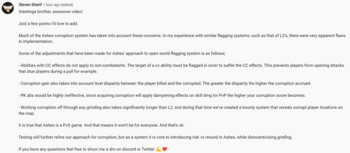
- ↑ 16.0 16.1 16.2 16.3 16.4 16.5 16.6 16.7 Livestream, May 22, 2017 (42:33).
- ↑ 17.0 17.1 17.2 17.3 17.4 17.5 17.6 17.7 17.8 17.9 Podcast, May 5, 2017 (43:05).
- ↑ 18.0 18.1 18.2 Interview, May 11, 2018 (5:05).
- ↑ 19.0 19.1 Livestream, November 17, 2017 (35:20).
- ↑ Podcast, April 11, 2021 (38:31).
- ↑ 21.0 21.1 21.2 21.3 21.4
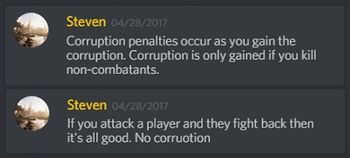
- ↑
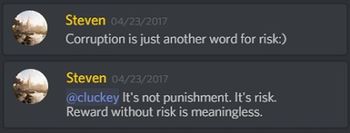
- ↑ 23.0 23.1 23.2 23.3 Interview, July 9, 2023 (36:56).
- ↑ Livestream, January 30, 2020 (1:40:48).
- ↑
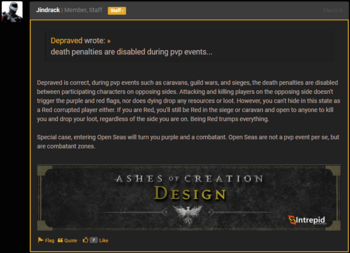
- ↑ 27.0 27.1 27.2 27.3 27.4 27.5 27.6 27.7 Interview, April 27, 2017 (0:17).
- ↑ 28.0 28.1 28.2

- ↑ 29.0 29.1 29.2 Interview, April 22, 2019 (54:40).
- ↑ 30.0 30.1 30.2 Livestream, November 17, 2017 (29:45).
- ↑ 31.0 31.1 31.2 31.3 31.4

- ↑ 32.0 32.1 32.2 32.3

- ↑ 33.0 33.1 33.2 Interview, April 27, 2017 (1:18).
- ↑ 34.0 34.1 Livestream, February 24, 2023 (1:12:24).
- ↑ 35.0 35.1 Livestream, April 30, 2021 (1:14:49).
- ↑ 36.0 36.1 36.2 36.3

- ↑ Livestream, August 27, 2021 (1:20:09).
- ↑ Livestream, August 27, 2021 (1:20:51).
- ↑ 39.0 39.1
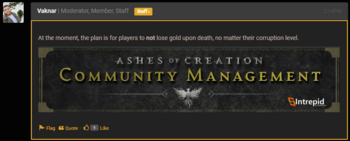
- ↑ Livestream, March 31, 2023 (54:22).
- ↑ Livestream, June 25, 2021 (1:32:24).
- ↑ Interview, February 1, 2017 (39:33).
- ↑ Livestream, July 9, 2018 (20:41).
- ↑ 44.0 44.1 44.2 Interview, July 18, 2020 (44:35).
- ↑ 45.0 45.1 Interview, July 19, 2020 (30:51).
- ↑ 46.0 46.1 Livestream, April 28, 2023 (1:27:18).
- ↑

- ↑ Livestream, June 4, 2018 (2:18).
- ↑
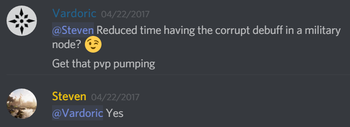
- ↑ Livestream, June 26, 2020 (1:50:24).
- ↑ 51.0 51.1 51.2 51.3 51.4 51.5 51.6

- ↑ 52.0 52.1 52.2 Interview, April 27, 2017 (9:28).
- ↑ 53.0 53.1
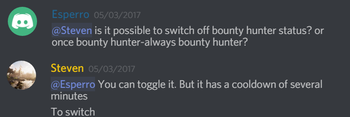
- ↑

- ↑ 55.0 55.1 Livestream, May 24, 2017 (48:00).
- ↑ Livestream, July 26, 2019 (1:20:48).
- ↑ Livestream, June 25, 2021 (1:06:22).
- ↑ Interview, January 20, 2017 (06:12).
- ↑ The mighty beard!
- ↑ Interview, April 27, 2017 (9:28).
- ↑ Interview, October 20, 2018 (15:51).
- ↑

- ↑ Livestream, February 28, 2020 (1:14:38).
- ↑ 64.0 64.1 64.2 Livestream, August 31, 2023 (2:08:54).
- ↑ Livestream, August 31, 2023 (2:06:21).
- ↑ Livestream, April 7, 2023 (1:19:41).
- ↑ Livestream, August 26, 2022 (1:17:04).
- ↑ Livestream, May 19, 2017 (28:04).
- ↑ Livestream, January 18, 2018 (31:05).
- ↑ Livestream, April 28, 2023 (2:06).
- ↑ Livestream, March 31, 2023 (1:00:16).
- ↑ 72.0 72.1 Livestream, May 12, 2017 (24:52).
- ↑

- ↑

- ↑ Livestream, July 28, 2023 (3:58).
- ↑ Livestream, October 28, 2022 (1:34:52).
- ↑

- ↑ 78.0 78.1 Livestream, July 30, 2021 (1:10:34).
- ↑ 79.0 79.1 Podcast, April 11, 2021 (34:41).
- ↑ 80.0 80.1 Livestream, December 2, 2022 (2:41).
- ↑ 81.0 81.1 Interview, July 8, 2020 (1:05:27).
- ↑ 82.0 82.1 Livestream, November 30, 2020 (1:09:06).
- ↑ Livestream, October 31, 2018 (44:12).
- ↑

- ↑ 85.0 85.1 Podcast, April 23, 2018 (49:21).
- ↑

- ↑
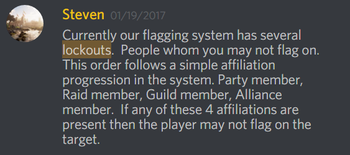
- ↑ 88.0 88.1 88.2 88.3 88.4

- ↑ 89.0 89.1 89.2 Interview, August 24, 2018 (8:35).
- ↑ 90.0 90.1 Video, February 29, 2024 (19:35).
- ↑ Livestream, September 24, 2021 (51:20).
- ↑ 92.0 92.1 92.2 Livestream, March 26, 2021 (1:07:33).
- ↑ 93.0 93.1

- ↑ 94.0 94.1 Interview, July 18, 2020 (27:11).
- ↑ Podcast, July 15, 2023 (26:31).
- ↑ Livestream, April 28, 2023 (1:18:48).
- ↑ Podcast, July 15, 2023 (28:28).
- ↑ 98.0 98.1 Livestream, January 29, 2021 (1:24:27).
- ↑ Livestream, September 27, 2018 (47:46).
- ↑ Livestream, November 30, 2023 (1:52:37).
- ↑ 101.0 101.1 101.2 Interview, September 10, 2023 (53:47).
- ↑ 102.0 102.1 Livestream, February 25, 2022 (1:06:45).
- ↑ 103.0 103.1 Livestream, April 29, 2022 (1:08:27).
- ↑ Livestream, July 28, 2017 (50:22).
- ↑ Livestream, March 28, 2020 (1:58:24).
- ↑ 106.0 106.1 106.2 106.3 106.4 106.5 Livestream, March 29, 2024 (3:21).
- ↑ Livestream, May 19, 2017 (13:37).
- ↑ Ashes of Creation Forums - Former Lineage 2 PvP'er wanting to discuss PvP loopholes.
- ↑ 109.0 109.1 Interview, February 7, 2021 (13:14).
- ↑ Interview, July 29, 2020 (16:46).
- ↑ 111.0 111.1 Livestream, December 2, 2022 (1:26:02).
- ↑ Interview, May 11, 2018 (15:41).
- ↑

- ↑ 114.0 114.1 114.2 114.3 Livestream, June 25, 2021 (1:15:37).
- ↑ Livestream, February 24, 2023 (1:29:45).
- ↑ 116.0 116.1 Livestream, June 30, 2022 (1:14:52).
- ↑ 117.0 117.1 Livestream, August 27, 2021 (1:22:56).
- ↑ 118.0 118.1 Livestream, December 22, 2020 (1:13:51).
- ↑ Livestream, May 15, 2017 (36:23).
- ↑ Interview, July 9, 2023 (38:03).
- ↑ Video, December 2, 2022 (16:29).
- ↑ Livestream, May 31, 2023 (1:08:39).
